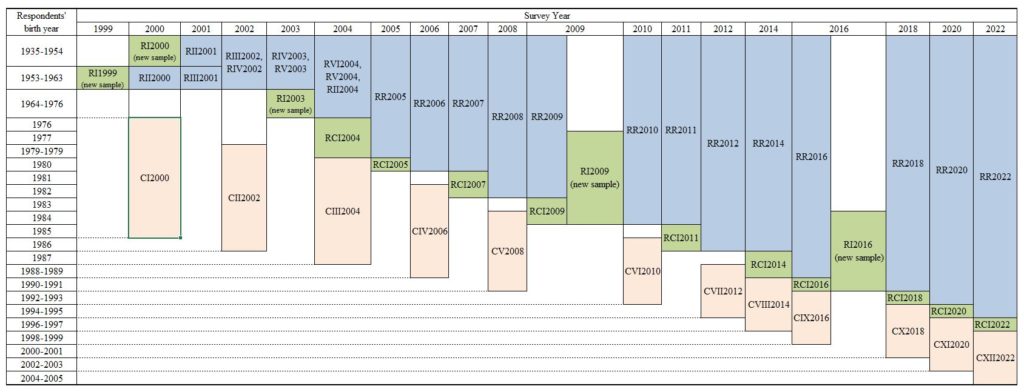PSFD is a long-term longitudinal survey project focusing upon families, with survey regions covering Taiwan and southeast China (including Shanghai, Zhejiang, and Fujian).
The original sample design of the Taiwan PSFD survey aimed to cover the adults aged over 25 and living in Taiwan as the targeted population. As of 2020, we have five different main samples who were born in different years, with their first-wave surveys conducted in 1999, 2000, 2003, 2009 and 2016. For the respondents who successfully complete the first-wave questionnaire, follow-up surveys are conducted on a regular basis. Follow-up surveys were conducted annually until 2012; after 2012, follow-up surveys have been conducted every two years. Starting from 2000, the sample has been expanded to the children of the main respondents. When the children are aged between 16 and 24, they are interviewed using the questionnaire designed for children (Questionnaire C); once after the children reach the age of 25, they are treated as the main respondents, and interviewed using the first-wave questionnaire of the main respondents (Questionnaire RCI). After that, the children are re-interviewed using the same questionnaire as the main respondents (Questionnaire R).
As mentioned above, there are three types of questionnaires in the Taiwan PSFD survey: Questionnaire RCI, Questionnaire R, and Questionnaire C. The core modules and the respondents administered these three types of questionnaires are explained below.
The first-wave questionnaire of the main respondents is assigned to the main respondents who are interviewed for the first time, and the children of the main respondents who are over 25 and interviewed for the first time as main respondents. The questionnaire for the former is labeled RI; and the questionnaire for the latter is labeled RCI. Some of the core modules in Questionnaires RI and RCI are the same as those in the follow-up questionnaire designed for the main respondents, such as the respondent’s demographic information (for example, health condition), employment status and job-related information, marital status, spousal demographic information and working information (for partnered respondents only), living arrangements, family income and expenditures, children care and education, and demographic traits and interactive relationship with important family members (including parents, parents-in-law, children, and siblings). In addition to these core modules, the Questionnaires RI and RCI contain questions on birthplace, language usage, educational experience, parents and family information at age 16, military service (for male respondents only), first-job-related information, working and residential situations at the time of marriage (for married respondents only), filial attitudes, family values, familial relationships, and participation in family activities.
The follow-up questionnaire for the main respondents is designed for the main respondents who have successfully completed Questionnaire RI, as well as the children of the main respondents who have completed Questionnaire RCI. Between 2000 and 2004, the follow-up questionnaire is labeled with an initial R, followed by a Roman numeral standing for the wave of the interview. For example, the questionnaire for the second-wave survey of the main respondents is labeled RII, and the questionnaire for the third-wave survey is labeled as RIII. Since 2005, the follow-up questionnaires for the main respondents have been uniformly labeled as RR. The core modules of the follow-up questionnaire for the main respondents include the respondent’s demographic information (such as health condition), employment status and job-related information, marital status, spousal information and working-related information, living arrangements, family income and expenditures, fertility intention, demographic characteristics of important family members (including parents, parents-in-law, children, and siblings), and kinship relationship.
The questionnaire for children aged 16-24 (Questionnaire C) is applicable for the main respondents’ children who are between 16 and 24 years of age. The questionnaire is labeled with an initial C, with an adjacent Roman numeral indicating the wave of the interview. The core modules contain questions on educational experiences and the current educational situations of the child respondents. Even though some of the core modules in Questionnaire RR are also included in Questionnaire C, the contents of the questions are slightly simplified in consideration of the child respondents’ age.

In 2004, a counterpart survey in China was initiated in Shanghai, Zhejiang, and Fujian. The birth years of the sample of the China survey are the same as the first three groups of the main sample of the Taiwan survey. Follow-up interviews for the China sample were conducted in 2006, 2011, 2013, 2017, and 2019 respectively. The questionnaires of the China survey by and large originate from the concurrent questionnaires used in Taiwan. However, the China survey is different from that of Taiwan in that the children of the main respondents are not included as part of the sample in China.
